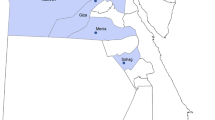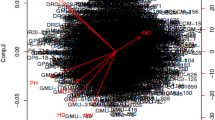Abstract
This paper presents results of studying the genetic diversity of 126 sunflower inbred lines from the collection fund of the Experimental Farm of Oilseeds of Kazakhstan for protein and SSR markers. The polymorphism of collections in terms of the composition of helianthinin, seed storage protein, was not high. In the zone of fast-moving proteins, three variants of components were found that are characteristic of all types of inbred lines. At the same time, components specific to lines with genes rf and Rf were identified. PCR analysis of DNA of inbred lines by 16 SSR markers showed no variations in the amplification products of locus ORS428 and low polymorphism of locus ORS785 (PIC ≤ 0.2). The following markers in the studied collections showed high polymorphism (PIC > 0.8): ORS316, ORS381, ORS437, ORS456, ORS505, ORS630, ORS761, and ORS925. Based on molecular marking, the registration of inbred lines of the Kazakhstan Collection Fund was carried out. In order to assess the level of hybridity of F1 seeds of commercial sunflower hybrids, SSR markers were selected that can differentiate the genetic material of the original parental lines in the DNA of the hybrid.



Similar content being viewed by others
REFERENCES
Poperelya, F.O., Genetic interpretation of electrophoregrams of helianthinin from sunflower F1 seeds, Cytol. Genet., 2000, vol. 34, no. 2, pp. 84–90.
Bochkovoy, A.D., Antonova, T.S., Kamardin, V.A., Araslanova, N.M., Veter, I.I., Guchetl, S.Z., and Chelyustnikova, T.A., The efficiency of different methods of determination of the genetic purity of the seed lots of self–pollinated lines and hybrids of the F1 generation of sunflower, Oil Crops. Sci. Techn. Bull. VNIIMK, 2014, vol. 157–8, no. 1, pp. 1–5.
Aksyonov, I.V. and Mishchenko, L., Use of electrophoretic spectra of reserve seed proteins to improve typicalness of sunflower parental lines, Russ. Agric. Sci., 2016, vol. 42, nos. 3–4, pp. 211–214. https://doi.org/10.3103/S1068367416030034
Sivolap, Y.M., Molecular markers and plant breeding, Cytol. Genet., 2013, vol. 47, no. 3, pp. 188–195. https://doi.org/10.3103/S0095452713030080
Paniego, N., Echaide, M., Munoz, M., Fernandez, L., Torales, S., Faccio, P., Fuxan, I., Carrera, M., Zandomeni, R., Suarez, E.Y., and Hopp, H.E., Microsatellite isolation and charaterization in sunflower (Helianthus annuus L.), Genome, 2002, vol. 45, no. 1, pp. 34–43. https://doi.org/10.1139/G01–120
Yu, J.K., Mangor, J., Thompson, L., Edwards, K.J., Slabaugh, M.B., and Knapp, S.J., Allelic diversity of simple sequence repeat markers among elite inbred lines in cultivated sunflower, Genome, 2002, vol. 45, no. 4, pp. 652–660. https://doi.org/10.1139/g02–025
Tang, S., Yu, J.K., Slabaugh, M.B., Shintani, D.K., and Knapp, S.J., Simple sequence repeat map of the sunflower genome, Theor. Appl. Genet., 2002, vol. 105, no. 8, pp. 1124–1136. https://doi.org/10.1007/s00122–002–0989–y
Mandel, J.R., Dechaine, J.M., Marek, L.F., and Burke, J.M., Genetic diversity and population structure in cultivated sunflower and a comparison to its wild progenitor, Helianthus annuus L., Theor. Appl. Genet., 2011, vol. 123, no. 5, pp. 693–704. https://doi.org/10.1007/s00122–011–1619–3
Zeinalzadeh-Tabrizi, H., Haliloglu, K., Ghaffari, M., and Hosseinpour, A., Assessment of genetic diversity among sunflower genotypes using microsatellite markers, Mol. Biol. Res. Commun., 2018, vol. 7, no. 3, pp. 143–52.
Pankovic, D., Application of molecular markers if sunflower breeding, Genetika, 2007, vol. 39, no. 1, pp. 1–11. https://doi.org/10.2298/GENSR0701001S
Imerovski, I., Dimitrijevic, A., Miladinovic, D., Dedic, D., Jocic, S., and Miklic, V., Molecular profiles of sunflower lines resistant to broomrape (Orobanche numana Wallr.), in Proc. Int. Symp. on Broomrape (Orobanche spp.) in Sunflower. Chisinau, Republic of Moldova, 2011, p. 25.
Duca, M., Port, A., Midoni, A., Rotaru, T., and Anisimova, I., RAPD analysis of the genetic variation among CMS, Rf lines and hybrid sunflower genotypes, J. Acad. Sci. Moldova,Life Sci., 2010, vol. 2, no. 31, pp. 103–109.
Duca, M., Port, A., and Şestacova, T., Screening of the R2 rust resistance gene in different sunflower genotypes using SSR markers. J. Acad. Sci. Moldova,Life Sci., 2011, vol. 2, no. 314, pp. 106–110.
Port, A., Nechifor, V., Midoni, A., and Duca, M., Usefulness of the diagnostic markers for the restorergene Rf1 in inheritance studies at sunflower, Ann. Alexandru Ioan Cuza Univ., Sect. II.a Genetics Mol.Biol., 2013, vol. 14, no. 2, pp. 11–19.
Markin, N.V., Tikhobaeva, V.E., Tikhonova, M.A., Gavrilova, V.A., Tolstaya, T.T., and Usatov, A.V., Genomic DNA polymorphism in annual sunflower species, Oil Crops. Sci. Techn. Bull. VNIIMK, 2010, vol. 2, no. 144–5, pp. 3–7. https://doi.org/10.3844/ajbbsp.2014.136.140
Guchetl, S.Z., Tchelustnikova, T.A., and Antonova, T.S., Certification of new sunflower lines and hybrids of VNIIMK breeding by means of biochemical and molecular markers, Oil Crops. Sci. Techn. Bull. VNIIMK, 2015, vol. 163, no. 3, pp. 16–23.
Usatov, A.V., Gorbachenko, F.I., Azarin, K.V., Gorbachenko, O.F., Tikhobaeva, V.E., and Markin, N.V., The relation between the heterosis effect of hybrids and genetic distance of sunflower parental lines vol, Oil Crops. Sci. Techn. Bull. VNIIMK, 2013, vol. 155-6, no. 2, pp. 8–13.
Usatov, A.V., Klimenko, A.I., Azarin, K.V., Gorbachenko, O.F., Markin, N.V., Tikhobaeva, V.E., Kolosov, Yu.A., Usatova, O.A., Bakoev, S., Makarenko, M., and Getmantseva, A., The relationship between heterosis and genetic distances based on SSR markers in Helianthus annuus,Am. J. Agric. Biol. Sci., 2014, vol. 9, no. 3, pp. 270–276. https://doi.org/10.3844/ajabssp.2014.270.276
Markin, N.V., Gorbachenko, O.F., Tikhonova, M.A., and Usatov, A.V., Condominant markers of rf1 gene in cultivated sunflower, Oil Crops. Sci. Techn. Bull. VNIIMK, 2010, vol. 142–3, no. 1, pp. 3–8.
Galili, G. and Feldman, M., Genetic control of endosperm proteins in wheat. 2. Variation in high molecular weight glutenin and gliadin subunits of Triticum aestivum,Theor. Appl. Genet.,1983, vol. 66, no. 1, pp. 77–86. https://doi.org/10.1007/BF00281853
Kimura, M. and Crow, J.F., The number of alleles that can be maintained in a finite population, Genetics, 1964, vol. 49, no. 4, pp. 725–38.
Nei, M., Analysis of gene diversity in subdivided populations, Proc. Natl. Acad. Sci. U. S. A., 1973, vol. 70, pp. 3321–3323.
Lewontin, R.C., Testing the theory of natural selection, Nature, 1972, vol. 236, pp. 181–182.https://doi.org/10.1038/236181a0
Yeh, F.C. and Boyle, T.J.B., Population genetic analysis of codominant and dominant markers and quantitative traits, Belgian J. Bot., 1997, vol. 129, pp. 157–163.
Žilić, S., Barać, M., Pešić, M., Crevar, M., Stanojević, S., Nišavić, A., Saratlić, G., and Tolimir, M., Characterization of sunflower seed and kernel proteins, Helia, 2010, vol. 33, no. 52, pp. 103–114. https://doi.org/10.2298/HEL1052103Z
Nikolić, Z., Vujaković, and Jevtić, Genetic purity of sunflower hybrids Determined on the basis of isozymes and seed storage proteins, Helia, 2008, vol. 31, no. 48, pp. 47–54. https://doi.org/10.2298/HEL0848047N
Anisimova, I.N., Proteins of Compositae’s seeds: heterogeneity, poly-morphism, usage in selection and genetic researches (review), Agrarn. Rossiya, 2015, vol. no, pp. 27–35.
Zhang, L., Le Clerc V., Li S., and Zhang D. Establishment of an effective set of simple sequence repeat markers for sunflower variety identification and diversity assessment, Can. J. Bot., 2005, vol. 83, no. 1, pp. 66–72. https://doi.org/10.1139/b04–155
Hvarleva, Tz., Bakalova, A., Chepinski, I., Hristova-Cherbadji, M., Hristov, M., and Atanasov, A., Characterization of Bulgarian sunflower cultivars and inbred lines with microsatellite markers, Biotechnol. Biotechnol. Eq., 2007, vol. 21, no. 4, pp. 408–412.https://doi.org/10.1080/13102818.2007.10817484
Dimitrijević, A., Imerovski, I., Miladinović, D., Tančić, S., Dušanić, N., Jocić, S., and Miklič, V., Use of SSR markers in identification of sunflower isogenic lines in late generations of backcrossing, Helia, 2010, vol. 33, no. 53, pp. 191–198. https://doi.org/10.2298/HEL1053191D
Duca, M., Port, A., Şestacova, T., Siniauskaya, M., Aksyonova, E., and Davydenko, O., Microsatellite marker application in sunflower (Helianthus annuus L.) Fingerprinting,Biotechnol. Biotechnol. Eq., 2013, vol. 27, no. 3, pp. 3772–3775. https://doi.org/10.5504/BBeQ.2013.0021
Pallavi, H.M., Gowda, R., Shadakshari, Y.G., Bhanuprakash, K., and Vishwanath, K., Identification of SSR markers for hybridity and seed genetic purity testing in sunflower (Helianthus annuus L.), Helia, 2011, vol. 34, no. 54, pp. 59–66. https://doi.org/10.2298/HEL1154059P
Sudharani, M., Rao, P.S., and Subba, RaoL.V., Identification of SSR markers for testing of hybridity and seed genetic purity in maize (Zea mays L.), Int. J. Sci. Res., 2014, vol. 3, no. 10, pp. 92–95.
Funding
This study was supported by the grant from the Ministry of Education and Science of the Republic of Kazakhstan 0788/GF4 and program-oriented financing of the Ministry of Agriculture of the Republic of Kazakhstan (BP 267 Ministry of Agriculture of the Republic of Kazakhstan, O. 0868).
Author information
Authors and Affiliations
Corresponding author
Ethics declarations
The authors declare no conflict of interest. This article does not contain any research using humans and animals as objects.
Additional information
Translated by K. Lazarev
About this article
Cite this article
Bulatova, K.M., Mazkirat, S., Gavrilova, O.A. et al. Genetic Diversity of Inbred Sunflower Lines of the Kazakhstan Collection Fund for Protein and SSR Markers. Cytol. Genet. 54, 10–17 (2020). https://doi.org/10.3103/S009545272001003X
Received:
Revised:
Accepted:
Published:
Issue Date:
DOI: https://doi.org/10.3103/S009545272001003X




